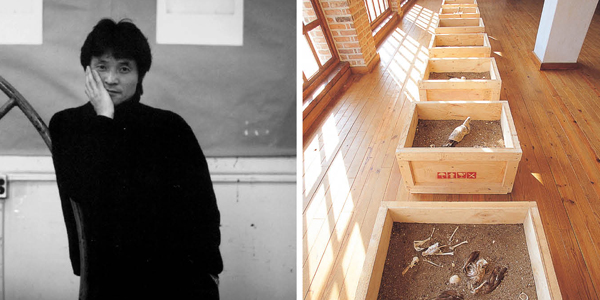
- Updated 2021.1.29 10:26
- All Articles
-
member
icon
-
facebook
cursor
-
twitter
cursor
|
CommunityInterviews |
An artist's focus on social causesKoh Gill Chun, April 3 artist and activist |
|
|
| |
 |
|
| ▲ Left, a self portrait of Koh Gill Chun. Right, “Excavation” (Installation, 2002). Photos courtesy Koh Gill Chun |
“Koh Gill Chun is the most active ‘Sasam artist’ today.”
Those are the words of art critic Kim Yu Jeong, who has followed Koh’s career from its inception.
Koh is a Jeju native who left the island for an 11-year period, returning to Jeju in 1986.
When asked what prompted his involvement in art related to Sasam – the 1948 military conflict and trauma of Jeju’s people – he referred to the work of American intellectual Noam Chomsky.
“I read Chomsky’s book, ‘What Uncle Sam Really Wants’ [1992], and in it he mentioned the ‘Cheju Uprising.’ I was really shocked that a writer in the US knew of this event in our history,” Koh replied.
This sparked his interest, and he soon began following the Minjung, or People’s Movement for Democracy.
He also has a personal connection to the historical event.
“My mother’s first husband was killed during Sasam,” he said. “She then married my father, but to this day, my elder two brothers [sons of the man who was killed] don’t want any involvement with Sasam issues.”
Koh was working as a designer at Jeju Ilbo (a Korean newspaper) in 1994 when the Tamna Artist Association dedicated to Sasam-related art held its first exhibition. He has been a member of the association since then.
While Koh doesn’t focus entirely on Sasam art “for the healing of Jeju’s mind,” he does prefer to create art “for social change” with themes of peace, healing, and environmental protection.
Creating art that focuses on trauma for the purpose of healing can take its toll on the artist.
When asked about his own peace of mind in light of his often graphic and deeply tragic art, he replied that for him the balance “is in the creative act itself, which feeds my spirit.”
Additionally, he cites his solid art education, which permits him to retreat into a theoretical perspective and thus gain distance from the emotional impact.
Several of Koh’s works can be found in the Jeju April 3rd Peace Park Memorial Hall. These include a vivid series of alto-relievo sculptures which depict the various types of death suffered by massacre victims.
The most significant of his Sasam works, Koh feels, was a frottage piece he created last year. Using a technique along the lines of gravestone rubbing, he created it by rubbing charcoal on traditional Korean paper that was laid over victims’ clothing excavated from a mass grave.
“Having the real object in hand,” he said referring to the article of clothing, “was deeply moving.”
Koh has recently created five works of site-specific graffiti protest art related to the controversial Gangjeong naval base project.
He has also participated in two art residency programs in the US, during which he focused on Jeju’s environmental issues and loss of bird habitat due to development.
Koh cites Picasso, Joseph Beuys, and Hans Haake as three artists whose works have inspired him – as much for their political and social themes as their composition.
The universal themes in his own work, according to Koh, focus on separation and division – and, a heart-to-heart connection as a means of healing.
This can be achieved through art, he feels – by forging a link between the art and its viewer, and between the art and the artist in the creative act.
Koh has explored a variety of media including painting, drawing, printmaking, frottage, sculpture, digital, installation, video, and mixed.
He is particularly well-known for his printmaking and is in the midst of teaching a three-year printmaking program at Hongik University in Seoul, to which he travels weekly. He previously taught at Ulsan University.
Koh always knew he would be an artist, he says, and comes from an artistic family.
In the spring of 2012, he will have a printmaking exhibition in the US. His works will be displayed in Seattle during March or April and then in Santa Rosa for the month of May.
As to the future of his art, he wants to paint with “a deeper spiritual mind” regarding the ecosystem of Jeju. He cites the current local art trend, of portraying only beautiful landscapes, as the commercialization of art and prefers to reveal deeper issues.
He will also continue Sasam art, particularly related to the ongoing excavation of mass graves.
Does he feel that his work is understood? Yes, he does, but states that he would like future work to be “less scary and more touching.”
Dr. Hilty is a cultural health psychologist.
|
|
|
|
|
|
|
|
|
|
|
ⓒ Jeju Weekly 2009 (http://www.jejuweekly.com)
All materials on this site are protected under the Korean Copyright Law and may not be reproduced, distributed, transmitted, displayed, published without the prior consent of Jeju Weekly. |
|
|
|
|
| Jeju-Asia's No.1 for Cruise |
|
|
|
Mail to editor@jejuweekly.com | Phone: +82-64-724-7776 Fax: +82-64-724-7796
#505 jeju Venture Maru Bldg,217 Jungangro(Ido-2 dong), Jeju-si, Korea, 690-827
Registration Number: Jeju Da 01093 | Date of Registration: November 20, 2008 | Publisher: Hee Tak Ko | Youth policy: Hee Tak Ko
Copyright ⓒ 2009 All materials on this site are protected under the Korean Copyright Law and may not be reproduced, distributed, transmitted, displayed, published
without the prior consent of jeju weekly.com.

|




















